 Hebrus River I assume you guys expect something entirely different in this letter since I have gone on a journey no Christian has undertaken in about a century! The most interesting thing that happened to me was being nearly overturned in the Hebrus river, and if I at all cared for the praises one receives once they die, I'd be sorry for having missed the conclusion of swimming down the same river in which the head of Orpheus repeated verses such a long time ago:
Caput a cervice revulsum,
Gurgite cum medio, portans Oeagrius Hebrus
Volveret, Euridicen vox ipsa, et frigida lingua
Ah! Miseram Euridicen anima fugiente vocabat,
Euridicen toto referebant flumine ripae. [1]
Who knows, maybe some of Alexander Pope’s witty friends might have found it a subject worth writing about.
At the moment, I am writing in a house situated on the banks of the Hebrus, which runs just under my window. My garden is full of tall cypress trees. My mind is filled with poetic thoughts right now! Summer has already arrived in this part of the world and the ground of Adrianople is laid out in gardens, and the banks of the river is set with rows of fruit trees. The Turks hang out there every evening. They choose a spot in the shade, spread out a carpet to sit and drink their coffee. The slaves entertain them by singing or playing instruments. Mr. Addison might here make the experiments he discusses in his travels; there isn’t one instrument among the Greek or Roman statues that is not played here.
I read Pope’s translation of Homer and found some passages that I didn't really understand the beauty of before. Much of the ancient Greek dress and fashion is still retained in Turkey. I seem to find remains of ancient Greece here in Turkey that can’t be found in any other country. It would be tedious to point out all of the similarities, but, for example, the princesses and great ladies spend their time embroidering veils in the same way we find Andromache and Helen described in The Illiad.
I should tell you a bit about the language here. The common Turk is very different from what is spoken at Court (which is a mixture of Arabic and Persian); it’s ridiculous to use common expressions when talking to a great man or lady just as it would be to speak broad Yorkshire or Somersetshire in the drawing room. The Turks have what they call a “sublime language,” a style that’s proper for poetry. I am sure you’d want to see an example of their finest poetry, and I’m happy to show you a copy of the verses that Ibrahim Bassa, a man of wit and learning, wrote for his princess, wife-to-be. I think you’ll agree this poem resembles the Song of Solomon, which was also written for a royal bride!
Stanza 1st
The nightingale now wanders in the vines;
Her passion is to seek roses.
I went down to admire the beauty of the vines;
The sweetness of your charms has ravished my soul.
Your eyes are black and lovely,
But wild and disdainful as those of a stag.
Stanza 2nd
The wished possession is delayed from day to day;
The cruel Sultan Achmed will not permit me to see those cheeks, more vermilion than roses.
I dare not snatch one of your kisses;
The sweetness of your charms has ravish'd my soul.
Your eyes are black and lovely,
But wild and disdainful as those of a stag.
Stanza 3rd
The wretched Pasha Ibrahim sighs in these verses;
One dart from your eyes has pierc'd thro' my heart.
Ah! when will the hour of possession arrive?
Must I yet wait a long time?
The sweetness of your charms has ravished my soul.
Ah! Sultana! stag-eyed, an angel amongst angels!
I desire and, my desire remains unsatisfied.
Can you take delight to prey upon my heart?
Stanza 4th
My cries pierce the heavens,
My eyes are without sleep,
Turn to me, Sultana, let me gaze on thy beauty.
Adieu, I go down to the grave.
If you call me, I return.
My heart is hot as sulphur; sigh, and it will flame.
Crown of my life! fair light of my eyes, my Sultana, my
princess.
I rub my face against the earth: I am drown'd in scalding tears,
I rave!
Have you no compassion? Will you not turn to look upon me?
It was really difficult for me to get these verses in a literal translation! The repetitions at the end of the first two stanzas are meant to sound musical; this is similar to the ancient manner of writing. The music of the verses seems to change in the third stanza, and he is more compassionate in the conclusion (where the “heart” is concerned). I feel this conclusion is more touching than our common practice of concluding a song of passion.
See? I’ve gone pretty far in my oriental learning, and honestly, I study very hard. I hope that my studies will allow me to continue entertaining you!
I plan on telling you all kinds of new stuff about this place! What will surprise you most is the way I look though…being in my Turkish clothing and all. I’ll attach a photo of myself! The first part of my dress is a pair of drawers that reach to my shoes and conceal my legs more modestly than your petticoats. They are a rosy color, brocaded with silver flowers. My shoes are white and embroidered with gold. Over this hangs my white silk gauze, edged with embroidery. The smock has wide sleeves that hang down my arm and is closed at my neck with a diamond button, but the shape and color of the bosom can be distinguished through it! The antery is a white and gold fitted waistcoat with very long sleeves falling back and fringed with deep gold fringe and have either diamond or pearl buttons. My caftan is also fitted to my body and reaches my feet, with very long sleeves. Over all of this is the belt, about four fingers wide, which is entirely made of diamonds and other gorgeous stones. Now depending on the weather, the curdee is a loose robe they throw on, made of a rich brocade (mine is green and gold) and lined with ermine or sables. The sleeves just barely reach below the shoulders.
The headdress is composed of a cap called talpock, which is made of fine velvet with pearls or diamonds in the winter, and of a light shinning silver stuff in the summer. The talpock is fixed on either side of the head that hangs a little ways down with a tassel that’s bound with a circle of diamonds or a richly embroidered handkerchief. On the other side of the head, the hair is laid flat and depending on individual taste, some ladies put flowers, feathers, or whatever they want; usually though, the ladies wear a large bouquet of jewels made to look like flowers, i.e. pearls, roses of different colored rubies, the jessamines of diamonds, jonquils or topazes, etc. Their hair hangs at its full length behind, divided into many tresses and braided with lots of pearls or ribbons!
It would be so surprising to find a woman who isn’t beautiful around here. They have the prettiest complexions in the world and generally large black eyes. The court of England does not have as many beauties as there are here. Generally, the ladies shape their eyebrows, and wear a lot of eyeliner so that at a distance, it adds very much to the blackness of them. They also paint their nails a rose-color, which I personally don’t like.
Now that I am a little more familiar with the customs in Turkey, I cannot but think of how extremely stupidity of all the writers were that gave accounts of the Turkish women. It’s so clear that these women have more liberty than we do. No woman, regardless of her rank, leaves the house without two muslins, one that covers her face but reveals her eyes, and another that hides her head and hangs half way down her back. They also cover their body shapes with a thing they call ferigee, which no woman appears without. This disguises them so that there is no way you can distinguish a great lady from her slave and no man dares to either touch or follow a woman in the street.
This masquerade allows them to do anything they want without getting discovered. So, you can imagine that not many wives are faithful in a country where they have nothing to fear from their lovers’ indiscretion. They don't have to worry about their husbands either; if they get a divorce, the rich ladies keep all of their money and property, and in addition, the husband is required to pay them. All in all, the Turkish women are the only free people in the Empire.
It’s true that the law allows men to have four wives, but a good man is not going to use that liberty and a woman of rank will definitely not tolerate it. If a man is unfaithful, he will keep his mistress in another house, just like the men in England do. Of all of the great men I know here though, only the Tefterdar keeps a few she-slaves and he has the reputation of a womanizer. Oh, and his wife lives with him but won’t see him ;)
All in all, people are not so different from one another as our travel bloggers would have us think. It would probably be more entertaining to make up some of my own customs but nothing is more pleasant than the truth.
The court in Adrianople is amazing. The Grand Signor’s eldest daughter, Fatma Sultan, was married a few days before I arrived. She is the widow of the late Vizier who was killed at Peterwaradin. Fatma never actually lived with him, but when the Vizier died, all of his wealth became hers. When Fatma met Mosayp, who is about fifty years old, she burst into tears. Although he is a man of quality and is a favorite of the Sultan, it wasn’t enough to make him appealing in the eyes of Fatma, who is only thirteen years old.
As powerful as the Grand Signor is, he trembles before the Turkish army. The army has absolute power over the government. If, for example, the minister of state were spoken badly of in a coffeehouse, the whole place would be shut down because there are spies everywhere. However, if a minister displeases the people he is dragged out to the street and his hands, head and feet are cut off. I can’t help but wish that English Parliament would send a bunch of your passive obedient men so they can see arbitrary government in its strongest light!
Yesterday, I went with the French Ambassadress to see the Grand Signor’s passage to the mosque. He was led by many janissaries (these were horse and foot guards) who wore huge white feathers on their heads and were dressed in lively colors. From a distance they looked like a garden of tulips! After the janissaries was the Aga of the janissaries, dressed in a purple velvet robe, lined with silver, whose two well-dressed slaves led him by a horse. Next to Aga, was the Kuzlir Aga dressed in a yellow cloth and six more horses richly furnished were led after him. I won’t bore you with all of the details on the various dresses and turbans (which distinguishes their rank) but know that they were all extremely rich and happy. There really couldn’t have been a more beautiful procession.
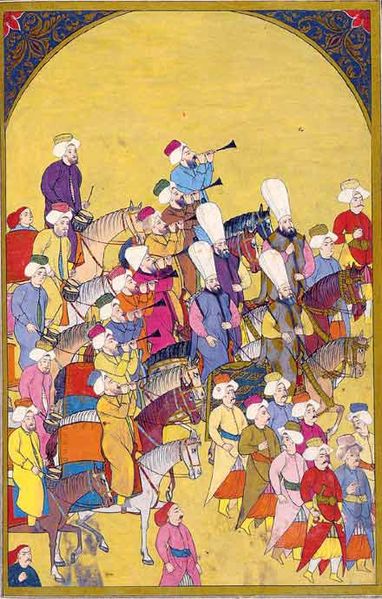 While this isn't exactly what we say, I thought it would help you guys get an idea! The music band of the Janissaries called mehterhane. They accompanied the company into battle and would play music according to the rhythm of the battle. The music was also used as a way of communication, such as retreat or attack. Ottoman miniature painting, from the "Surname-ı Vehbi" (fol. 171b). Topkapı Sarayı Müzesi, Istanbul. We also saw the Sultan, who looks about forty, and is very handsome and graceful. But his eyes are so full and black; there is something severe in his expression. He stopped under the window where we stood and looked at us very attentively.
I really can't stress enough the power the janissaries have in this country. I was having supper one night in a village on this side of Phillipopolis where our domestic guard met us. I asked for pigeons for my supper and one of my janissaries immediately ordered the cadi (the chief civil officer of the town) to send in some dozens. The poor man said he already sent some and couldn’t get any more. My Janissary immediately locked him up as a prisoner and out of respect to me, said he would punish him by my order, and if I wanted, he would bring me his head! This should show you the unlimited power these men have. The greatest man at Court speaks of them in a flattering tone only... But, I’ve said enough!
I’m not sure if this blog post is going to satisfy you, Abbe, but it’s clear that we have unreliable information regarding the manners and religion of these people. Most people who visit Turkey are merchants only interested in their own affairs, or travelers who don't stay long enough to give accurate reports.
I was thinking about Achmet-Beg, whom I met in Belgrade. He’s an effendi, or a scholar, and the scholars play prominent roles in the Turkish Empire. Talking to him gave me the opportunity to learn of their religion and morals in a way that maybe no Christian has ever had the chance to. I explained to Achmet-Beg the difference between the religion of England and Rome and he was happy to hear that there are many Christians who do not worship images or adore the Virgin Mary. He is not very fond of transubstantiation. I’m convinced that if Dr. Samuel Clarke had the chance to preach here, he would easily persuade his ideas to the Christians, whose notions are very little different from his anyway!
Mahometism is divided into as many sects as Christianity is. The Zeidi, Kadari, and Jabari reminded me of the Catholic, Luterhan and Calvinist sects we have, etc. The most prevailing opinion amongst the effendis is deism; however, this is kept secret from the people. Very few effendis (Achmet-Beg said there were none at all) would actually declare they didn’t believe in a God at all. Sir Paul Rycaut is wrong in calling the Muserin sect atheists because they are actually deists. Achmet-Beg didn’t admit to belonging to the Muserin sect, but he does deviate from some of Mahomet’s Law. For example, he drinks wine just as freely as we do. I asked him why he allows himself the liberty and he said although the prohibition of wine was a wise maxim, the prophet never intended on confining those who knew how to drink it with moderation. But he does avoid scandal and so he doesn’t drink it in public!
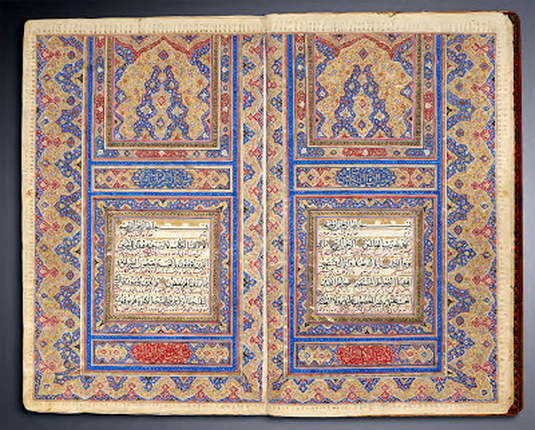 Manuscript of a Qajar Qur’an, Scribe: Abd al-Mudhnab al-Khatti al-Jani Abdallah Iran, Tehran, Qajar, dated 1233 H / 1817-8 CE Photo Credit: Islamic-Arts.org Achmet said that if I could read Arabic, I would really enjoy reading the Alcoran which is not at all like we English think it is. He said it’s of the purest morality written in the best language. Most of the copies we have are translations from the Greek priests, who would not hesitate to falsely interpret it--they are so corrupt and intolerant! Yet, they are not so different from the Romish Church. I have admit though, as much as I dislike the cruelty of your clergy, I dislike the barbarous persecutions of them when they don’t acknowledge the Pope even more.
Of all of the religions I’ve seen, the Arnounts seem the most particular. They are natives of Arnountlick and are the best militia in the Turkish Empire. They haven’t fully embraced Christianity or Mahometism and claim they are unable to judge which religion is best. But in order to avoid rejecting the truth, they follow both religions and so visit the mosque on Fridays and church on Sundays.
That is basically what I have gathered on the diversity of religions I have seen. Abbe, I am not going to apologize for the liberty I have taken in speaking of the Roman Catholic Church. I know you also expect me to tell you something about the antiquities of this country but there are barely any remains of ancient Greece. Anyway, I think I’ve told you everything worth telling in regards to my journey. When I’m in Constantinople, I’ll pick up on some more details and you’ll hear from me again!
Turkey feels like an entirely new world. I’m not going to bore you all with the details of our tedious journey, but I have to tell you what I saw in Sophia! It’s one of the most beautiful towns in the Turkish Empire and it’s famous for its hot baths. I purposely stopped in Sophia just to see the bathhouses. I hired a Turkish coach to drive me to the bagnio. The coach is entirely covered with scarlet cloth, lined with silk, and richly embroidered. So gorgeous! This covering hides the persons sitting inside, but can be thrown back. Many of the ladies peep through the lattices. When I arrived at the bathhouse at around 10 a.m., it was already filled with women. The bathhouse is built of stone and is in the shape of a dome. There weren’t any windows except for the roof, allowing a lot of light in. After I paid the portress who stands at the door (I noticed the ladies of quality paying her so I made sure to do the same), I entered a large, marble paved, room with four fountains of cold water; the water fell into basins first and then ran on to the floor in little channels which carried streams of water into the next room. There were also marble sofas, but they were so hot with steams of sulfur that you couldn’t possibly stay there with your clothes on.
Although I was not dressed like the women at the bathhouse (I just had one of my dresses on), they treated me with such kindness and civility. I am certain there isn’t a single lady back in England who would have treated a stranger with such politeness. They actually repeated over and over to me “Uzelle, pek uzelle,” which means, “Charming, very charming.”
They sat on sofas covered with cushions and rich carpets and their slaves sat behind them, but you couldn’t tell the difference in their social rank by their clothes because they were all…well, naked. However, there wasn’t anything sexually immodest about them! I cannot describe to you in words how utterly beautiful these women are. They walked and moved with the same grace that John Milton describes of Eve in Paradise Lost. They resembled the perfectly proportionate goddesses drawn by Guido and Titan, their skin is shiningly white, and their beautiful hair is divided into tresses and braided with either pearl or ribbon. I swear if it were the fashion to go naked, their faces wouldn’t be noticed. I greatly admired their fine skin and perfect body shapes. I secretly wished that Mr. Gervase [1] had the ability to go invisible and observe these ladies in their different postures, some lying on their cushions, others conversing, braiding hair, working, or drinking coffee…I think it would improve his art ;)
One of the women insisted I sit by her and undress for the bath. The ladies were adamant in persuading me to undress, but I had to refuse. In the end, I was forced to open my dress and show them my corset, which satisfied them. They couldn’t believe I was so locked up in that machine and they attributed my wearing it to my husband.
I wanted to spend more time with the women but Mr. W wanted to continue our journey to Constantinople early the next day, so I left before I really wanted. Anyway, I’m sure I entertained you with a sight you’ve never seen in your life and no male, travel book can inform you of! It is like death for a man to be caught in one of these places.
Welcome to my first post! I'm Lady Mary Wortley Montagu and I'm so excited to share my travels with all of you! Thank you for all of your emails and tweets! I'm in Belgrade now, about to set out to Adrianople and finally really begin my travels through Turkey!
 The first half of my trip around Europe! We stayed about 6 months before we headed on to Turkey! We first arrived in Rotterdam (see pics on twitter, @Lady_Mary_WM) and then traveled to The Hague, Cologn, and Nuremburg on our way to Vienna. The culture in Vienna is wonderful! I hate to say it, but I've strayed so far from the discipline of the church as to see an opera, Angelica's Victory Over Alcina by Johann Josef Fux, at the Garden of The Favorita and I LOVED it (don't judge me, Mr. Pope)! It was so dynamic and there were so many scene changes! Check out this short recording I did at the show!
In Vienna, I had a private audience with the Empress, (Elisabeth Christine of Brunswick-Wolfenbüttel) and spent time with the ladies at court. I have to tell you about the beauty of the Empress! Forgive my poetics, but even the all the words the poets have said of Juno and Venus could not measure up to her. She has the most amazing smile, fine hair, and perfect grace: even The Venus de' Medici was not more perfectly formed. Anyway, while I was visiting, I saw many ladies of the court and I have to say that fashion in Vienna is much different than England and France and much less practical. Women's hairstyles are a bit odd too. They build up their hair so high on their heads using piles of gauze and ribbon and cover it in powder and jewels to hide it. It seems far outside the realm of common sense, but even the Empress, as lovely as she is, must comply!
The only thing that's similar to our fashion in England is the petticoat, and that has ours outnumbered by a few yards . Sometimes the women just wear a scarf with anything they like underneath. Whenever the ladies feel like getting dressed up, they declare it Days of Gala and everyone comes over in their best outfits. They wear clothes embroidered in rich gold--but they don't seem to show much taste to them provided they are expensive! 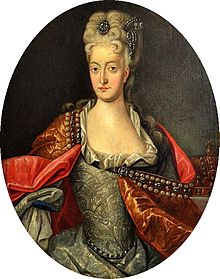 Portrait of Elisabeth Christine of Brunswick-Wolfenbüttel by Johann Gottfried Auerbach (1697–1753) One thing I do love about Vienna is the way the "older" women are treated. Here, a women of 35 is considered a young girl and is treated as young a beautiful! What a relief this would be to many young women in England who are already considered old maids; if only they had been born here instead! In Vienna, I was also encouraged to take a lover, though none of the women are coquettes or prudes. Here it seems that women are respected more based on the rank of their lovers than their husbands. It is quite common knowledge, even an expectation, that a women will take a lover; the ladies here couldn't understand why I would disgrace myself by not having a little intrigue. The women even control their lovers' estate and fortune. A young count even asked me to engage in a little affair of the heart! Obviously I said no, and had this happened in England, I would have been more offended but I spent enough time in Vienna to know that he was simply doing what he was obligated to do. "Gallantry and good breeding are as different in different climates as morality and religion" (66).
Marriage laws in Vienna are quite different from England, not that I know much about these things. Here it seems that dowries are limited to about 2,000 florins (about 200) and whatever money a woman possesses outside of the dowry is hers; her husband can't seize it or control what she does with it. As a result, many women end up wealthier than their husbands! But unfortunately, widows have no place in Vienna as they lose their rank when their husbands die.
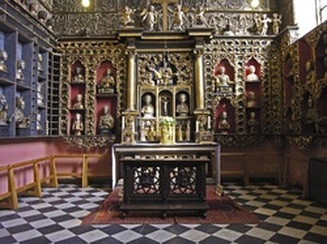 Basilica of St. Ursula's I know that you all expect to hear about the churches and convents. In Cologne, we toured the Basilica of St. Usrula's and it was beautifully decorated with rich images of saints, relics, and tons of pearls, diamonds, and rubies. I have to admit, I even found myself looking quite longingly at St. Ursula's pearl necklace…
In Vienna, I visited the convents, and St. Lawerence's was easily my favorite because of its ease and neatness. It seems much easier to live with than the nastiness and perpetual state of penance at the other convents. I couldn't help but laugh when they showed me a wooden head of our Savior that they swore spoke during the siege of Vienna (they said the open mouth was proof!). Here's a short video of the Chamber of the Bones in St. Ursula's, alleged to contain
the bones of martyred Princess and the 11,000 virgins who were massacred by the Huns (51). After all of this time in Vienna, we spent some time in Prague and Hanover, stopping at Leipzig and Brunswick in between. On the road to Leipzig I swear we almost died, the roads were so dangerous along the River Elbe. Mr. W slept through it all and I, being a good wife, didn't wake him. We barely stopped in Dresden, though I wish we could have stayed longer. The Saxon ladies as so affected, they would think it a mortal sin if they spoke or moved in a natural way.
In Hanover, the women are absolutely beautiful with rosy cheeks, snowy complexions, and coal black hair. The opera house too is much finer than the one in Vienna. We saw the Herrenhausen Gardens which were covered in snow, but still beautiful! There were so many orange trees! A brief video of the gardens We traveled back to Vienna and attended a carnival. Because of the war with the Turks, we weren't allowed to wear the typical carnival masks. We eventually left Vienna and arrived in Gyor, Hungary. For a long time, Gyor was the frontier between the Turkish and German empires. The Turks tried to conquer it many times, sometime successfully, but in the end, the Germans regained control. We continued our travels through beautiful and fruitful plains between Nosmuhl and Buda, but most of the region remains like a desert because of the long war with the Turks and the Emperor. Even worse were the towns of Adam and Fodowar, which are largely forest-like; this part of the country was better off when the Turks ruled. Because it's so little frequented, it was surprising to see the vast number of wild fowl, "which often live here to a good old age and undisturbed by Guns in quiet Sleep."
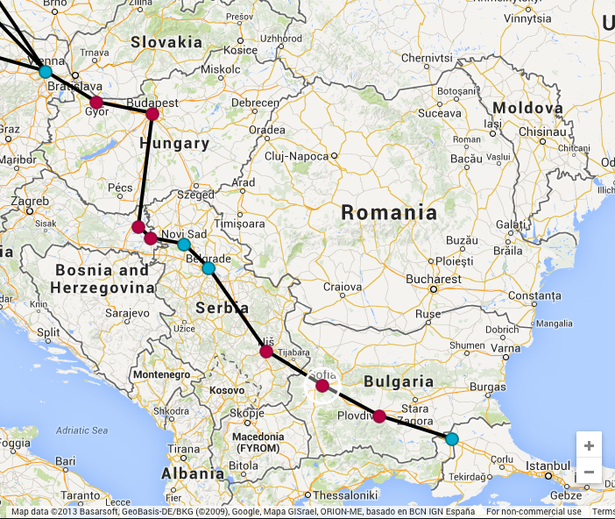 The second half of my journey to Turkey! We took our time and traveled cross-country from Vienna to Belgrade, and soon I'll be in Adrianople! We then passed through Mohatch, Danube, Esseek, and finally Bocowar where we waited until everything was clear concerning our crossing into the Turkish frontier. We were promised by General Bassa Seraskier to be well received in Turkey! We were told that we would be escorted by a Turkish convoy in Betsko, a village between Peterwaradin and Belgrade. When we finally arrived in Betsko, we were met by Turkish soldiers and then made our way to Belgrade. Belgrade is a strong city conquered by the Grand Vizier and strengthened by the numerous garrisons of the bravest soldiers who are commanded by the Bassa. Franky, I did not feel very comfortable here. We were expecting to leave in one night but the Bassa had detained us until he received orders from Adrianople.
Fortunately, we stayed in one of the best houses here and I made friends with our host, Achmet-Beg, whose father was a great Bassa. He dined with us every night and drank wine freely. He was so happy with the liberty of conversing with me; he explained to me some pieces of Arabian poetry, which are generally written in alternate verse, and are rather musical. Their expressions of love were so passionate and lively, and I noticed they were not so different from our own English poetry! I impressed Achmet-Beg by retelling some of the Persian tales that I know. He has such wit and is much more polite than many of our own Christian men back home.
However, these amusements did not hinder me from wanting to leave this place. I'll be leaving Belgrade for Turkey tomorrow. Make sure to follow me here on the blog and my on Twitter @Lady_Mary_WM to stay updated on my adventures in Turkey! *This post references letter 1-25 of The Turkish Embassy Letters, see the full-text here*
|

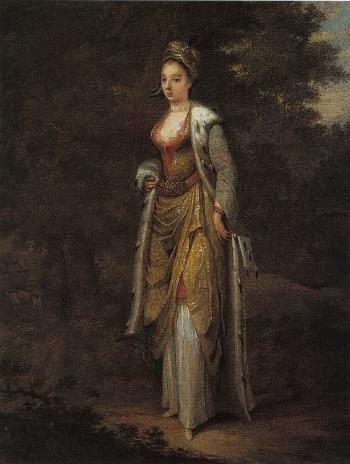






 RSS Feed
RSS Feed